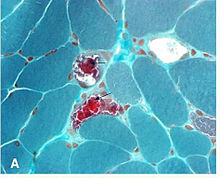Gömöri trichrome stain
Appearance


Gömöri trichrome stain is a stain used on muscle tissue.[2][3]
It can be used to test for certain forms of mitochondrial myopathy.
It is named for George Gömöri, who developed it in 1950.[4]
References
- ^ Kanodia KV, Vanikar AV, Goplani KR, Gupta SB, Trivedi HL (2008). "Sickle cell nephropathy with diffuse proliferative lupus nephritis: a case report". Diagn Pathol. 3: 9. doi:10.1186/1746-1596-3-9. PMC 2275218. PMID 18307766.
{{cite journal}}: CS1 maint: unflagged free DOI (link) - ^ "GOMORI TRICHROME". Retrieved 2009-04-06.
- ^ "Histology Lab: GOMORI TRICHROME". Retrieved 2009-04-06.
- ^ GOMORI, G. - A rapid one-step trichrome stain. Am. J. Clin. Path. 20: 661-664, 1950.
External links
![]() Media related to Gömöri trichrome stain at Wikimedia Commons
Media related to Gömöri trichrome stain at Wikimedia Commons
